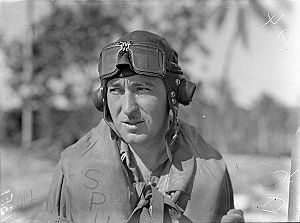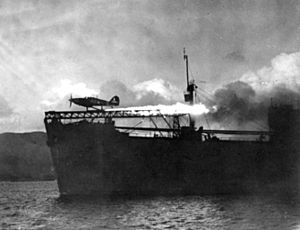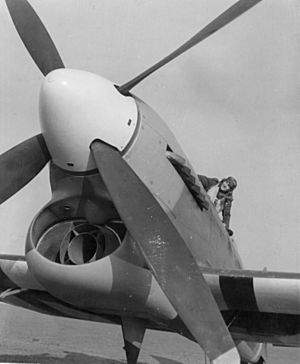Robert Spurdle facts for kids
Quick facts for kids
Robert Spurdle
|
|
|---|---|

Robert Spurdle, as a flight lieutenant in 1943 with No. 16 Squadron in Espiritu Santo
|
|
| Nickname(s) | Peter, Spud |
| Born | 3 March 1918 Wanganui, New Zealand |
| Died | 5 March 1994 (aged 76) Whitianga, New Zealand |
| Allegiance | New Zealand |
| Service/ |
Royal New Zealand Air Force (1939–1940; 1945–1946) Royal Air Force (1940–1945) |
| Rank | Wing Commander |
| Commands held | No. 80 Squadron |
| Battles/wars | Second World War
|
| Awards | Distinguished Flying Cross & Bar Mention in despatches |
Robert Lawrence "Peter" Spurdle DFC & Bar (March 3, 1918 – March 5, 1994) was a brave New Zealand pilot. He was known as a "flying ace" during World War II. This means he shot down ten enemy aircraft.
Born in Wanganui, New Zealand, Spurdle joined the Royal New Zealand Air Force (RNZAF) in 1939. After his flight training in 1940, he went to the United Kingdom. There, he joined the Royal Air Force (RAF). He flew Supermarine Spitfires during the Battle of Britain. He also fought in the Solomon Islands campaign. Later, he commanded No. 80 Squadron. After the war, Spurdle returned to the RNZAF. He became an engineer and enjoyed yachting. He passed away in 1994 when he was 76 years old.
Contents
Early Life and Joining the Air Force
Robert Lawrence Spurdle, called Peter by his family, was born in Wanganui on March 3, 1918. He went to Wanganui Collegiate School. After school, he worked in a warehouse. Peter decided he wanted to fly for the military. In 1939, he applied to join the Royal New Zealand Air Force (RNZAF). He was accepted and started his training in September.
World War II Service
Peter's training began a few weeks after World War II started. He trained to be a pilot for light bombers. He completed his training in Christchurch.
In June 1940, Peter and 22 other New Zealand pilots went to the United Kingdom. They joined the Royal Air Force (RAF). In July, he officially transferred to the RAF. He learned to fly the Supermarine Spitfire at Hawarden.
Fighting in the Battle of Britain
On August 21, Peter joined No. 74 Squadron. This squadron was led by a famous pilot named Sailor Malan. Peter started flying missions on August 28. Two weeks later, he helped damage a German Heinkel He 111 bomber.
In October, his squadron moved to Biggin Hill. Soon after, Peter had to bail out of his Spitfire. His plane broke apart while chasing a German Messerschmitt Bf 109 fighter. At the end of the month, he likely destroyed a Bf 109.
A few days later, he got his first confirmed victory. His squadron, along with No. 92 Squadron, met 60 Bf 109s over Maidstone. Peter shot down a Bf 109, which crashed near Ashford. He had just been promoted to flying officer.
On November 14, Peter's squadron stopped 50 German Junkers Ju 87 dive bombers. These bombers were over Dover and had 25 Bf 109s with them. Peter likely destroyed a Ju 87 and damaged two others. On December 5, he shot down another Bf 109.
Fighting Over the English Channel
In early 1941, the RAF changed its plans. They started flying over the English Channel and France. This was to make the German Luftwaffe fight them. On March 3, Peter shot down two Bf 109s. Later that month, he helped likely destroy a Junkers Ju 88 bomber. He also damaged a Dornier Do 217 bomber.
On April 6, Peter's Spitfire was damaged while attacking a German airfield in Belgium. Even so, on his way back, he saw a Messerschmitt Bf 110 fighter. He managed to shoot it down. Later that month, he moved to No. 92 Squadron. In May, he likely destroyed a Bf 109 and damaged another.
By June, Peter had new duties. He joined the Merchant Ship Fighter Unit. This unit used Hawker Hurricanes launched from ships. These "CAM ships" protected convoys from German bombers. Peter made two trips to the United States on these ships. There were no enemy attacks during these trips.
By February 1942, he was back with No. 92 Squadron. Two months later, he became a flight commander. He was also promoted to acting flight lieutenant.
On July 25, Peter destroyed a Bf 109. The next day, he shot down a Focke Wulf 190 over Hastings. The German pilot bailed out and was rescued. Peter visited the pilot, who was a German flying ace named Horst Bennokruger. Just two days later, Peter damaged another Fw 190. In early August, he damaged a Bf 109.
Later that month, he received the Distinguished Flying Cross (DFC). This award is for bravery in air combat. The official announcement said:
This officer is a keen and determined pilot. He has destroyed 5, probably destroyed 4 and damaged several more enemy aircraft. His devotion to duty has set a praiseworthy example.
Soon after getting his DFC, he took part in the Dieppe Raid. His squadron attacked German ships. Peter flew four missions that day. By the end of August, he was very tired. He moved to No. 116 Squadron for easier duties. In December 1942, he returned to New Zealand.
Service in the Solomon Islands
In New Zealand, Peter helped set up a training school for pilots. He did this from January to May 1943. Then, he became a flight commander in the RNZAF's No. 16 Squadron. This squadron flew Curtiss P-40 Kittyhawks. They were getting ready to serve in the Solomon Islands campaign.
By late June, the squadron was in Espiritu Santo. They flew anti-submarine patrols and stopped Japanese planes. The next month, they moved to Guadalcanal. Their main job was to protect American bombers. On August 13, Peter shot down a Japanese Hap fighter. This was a type of Mitsubishi A6M Zero. Nearly two weeks later, he destroyed a Zeke fighter, another Zero type.
The squadron also looked for Japanese boats carrying supplies. On one mission, Peter and his wingman damaged a boat at Choiseul Island. They also destroyed three Japanese patrol boats. In mid-September, the squadron returned to New Zealand.
Back to Europe
After a rest, Peter returned to England in April. He briefly joined No. 130 Squadron. Then, in May, he moved to No. 80 Squadron. This squadron was preparing for the invasion of Normandy. Peter became a flight commander by the end of May. On D-Day, his squadron escorted gliders. During this mission, Peter and his flight attacked a German tank.
Two months later, he took command of the squadron. Now an acting squadron leader, he oversaw the change from Spitfires to the Hawker Tempest plane. He led the squadron during the Battle of Arnhem. They attacked German flak guns (anti-aircraft guns).
After Arnhem, No. 80 Squadron moved to Holland. They first protected bridges and airfields. In December, they started offensive missions. Soon after, Peter damaged two Junkers Ju 188 bombers. In January 1945, he was very tired from fighting. He was sent to a headquarters role. Later that month, he received a bar to his DFC. This meant he had earned the DFC again. He received the DFC in a ceremony at Buckingham Palace later that year.
Peter didn't like his headquarters job. He volunteered to help guide air support. After training, he took part in Operation Varsity. This was a big airborne crossing of the Rhine River. He was with the British 6th Airborne Division. He led three RAF radio teams. They landed by glider at Wesel on March 24. Their job was to arrange air support for the ground troops. For this work, he was mentioned in official reports. He later worked with the 11th Armoured Division. He helped coordinate fighter planes as British forces moved towards the Elbe River. This is where he finished the war in May 1945.
By the end of the war, Peter, now a wing commander, had flown 565 missions. He was credited with destroying ten enemy aircraft. He also likely destroyed two more and damaged nine others.
Life After the War
In July 1945, Peter went to a gunnery school. A few days after arriving, his service with the RAF ended. He transferred back to the RNZAF. He returned to New Zealand in November. In April 1946, he left active service.
Back in civilian life, Peter started an engineering business in Wanganui. He became very interested in the sea. He took up diving and went on a four-month sailing trip around the South Pacific. After this, he spent four years building a catamaran boat called the Whai. Once it was finished, he sailed the Whai all the way to Japan. He wrote a book about building the boat and his trip called Into the Rising Sun, published in 1972.
He moved to Whitianga and finished building a second catamaran in 1978. He later wrote his life story, The Blue Arena, which came out in 1986. Peter passed away on March 5, 1994, in Whitianga. He was buried at Mercury Bay cemetery. He had three children with his wife, Shirley.



